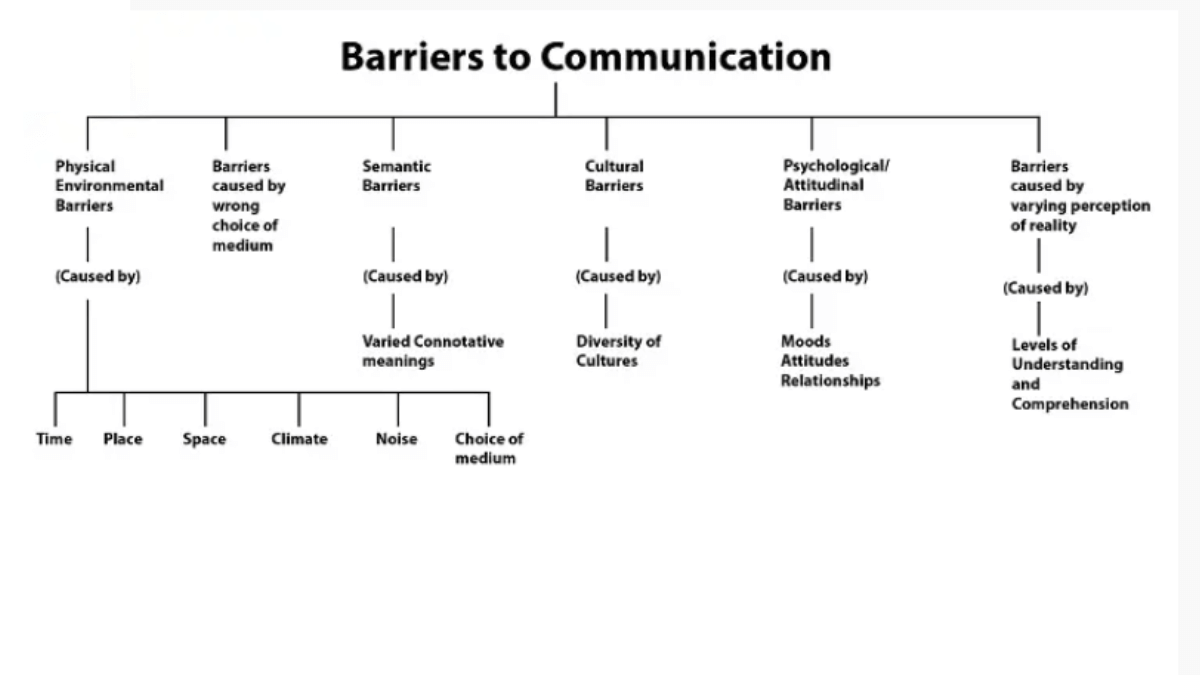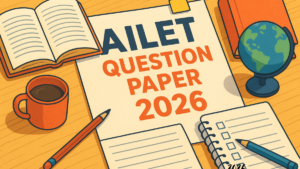Communication barriers are explained as follows: human existence and survival, as well as organisational survival, are dependent on communication. Communication is defined as the process of producing and disseminating ideas, information, points of view, facts, and sentiments among individuals. Communication is formed to reach a common understanding. However, if there are any communication barriers, the process of relaying essential information may become less effective, jeopardising your success. Furthermore, communication barriers may occur at any time during the communication process. This is referred to as a communication barrier.
Barriers of Communication Definition
Barriers of Communication, also known as In interpersonal communication, the message may not be received exactly as intended by the sender, hence, it’s critical that the communicator seeks feedback to ensure that the message is interpreted correctly. Moreover, active listening, clarification, and reflection skills may be beneficial. However, a successful communicator must also be aware of the hurdles to effective communication and how to avoid or overcome them, as there are numerous communication barriers that can arise at any point during the communication process.
Read: Adverb Definition And Examples
7 Barriers of Communication Examples & Types
Barriers might cause your message to be misinterpreted, and it is a stated fact that overcoming these limitations and communicating a clear and precise message are all part of effective communication. All 7 types of communication types with examples are discussed in the next portion of the article.
Language Barriers of communication
Because language is the most often used medium of communication, it is one of the most significant hurdles to efficient communication. Each major region has its own language, and dialects between regions can differ by a few kilometres, and even a thick dialect can make communication difficult. Diverse employees will have different linguistic skills even in the same workplace, and as a result, communication channels that transcend the corporation will be affected. Even when communicating in the same language, a message’s terminology can be a barrier if it is not fully understood by the receiver(s), who is unfamiliar with the terminology.
Regional idioms and expressions may be misinterpreted or even offensive to some people.
Psychological Barriers of communication
There are a variety of mental and psychological issues that can obstruct effective communication, such as stage fright, speech disorders, phobias, depression, and so on. Anger, fear, jealousy, insecurity, shyness, and close-mindedness are all psychological barriers that can obstruct communication. All of these conditions are difficult to manage at times and will obstruct communication.
However, it is possible that some people have a propensity of initiating an argument when someone disagrees with them, which can have a negative impact on both personal and professional relationships.
Emotional Barriers of communication
The ease and comfort with which a person can speak is determined by their emotional IQ, and a person who is emotionally mature will be able to communicate effectively. However, it is often obvious that those who let their emotions to rule their lives will experience issues.
For efficient communication, a perfect blend of emotions and facts is required, and emotions such as anger, irritation, and humour can cloud a person’s decision-making abilities, limiting the efficiency of their communication.
Cultural Barriers of communication
As the world becomes more globalised, any major office may contain people from many corners of the globe, and different cultures have varied interpretations of some core societal norms. From one culture to the next, clothing, religions (or lack thereof), food, drinks, pets, and general behaviour will differ dramatically.
As a result, we must take into account these various cultures while communicating and cultivating cross-cultural sensitivity in order to overcome such cultural obstacles. This is referred to as being culturally acceptable, as people and businesses frequently miss out on these chances owing to cultural obstacles.
Physical Barriers of communication
They are the most evident impediments to successful communication, and they are usually easily removed in concept at least, such as noise, closed doors, malfunctioning communication equipment, closed cabins, and so on. For example, in a large office, physical separation between employees, combined with faulty equipment, can create significant communication barriers.
Attitude Barriers of communication
Communication is also hampered by prejudice, distrust, emotional aggression, or discrimination based on gender, ethnicity, or religion. They arise as a result of a lack of drive or a refusal to adapt. Effective listening, criticism, problem-solving, and being open to change can all help you break down communication barriers.
Certain people, such as introverts or persons who are not very sociable, prefer to be left alone, whilst others want to be social or occasionally overly clinging. Some people have attitude problems, such as a large ego and disrespectful behaviour, which can be a communication obstacle.
Perception Barriers of communication
Different people view the same things in different ways, which is something we must keep in mind when communicating. Effective communication requires an understanding of the audience’s perception levels, and all messages or communications must be simple and straightforward. There should be no place for a diverse set of interpretations.
Physiological Barriers of communication
Certain ailments, diseases, or other limits may also obstruct good communication between an organization’s multiple channels, with the shrillness of voice, dyslexia, and other physiological barriers to successful communication being examples. These aren’t critical, though, because they can be readily adjusted for and deleted.
Hierarchical Barriers of communication
Organizational hierarchy can be a difficult communication barrier, and it can also exist inside a family, where there may be a power hierarchy, resulting in a lack of transparency or a communication barrier. Establishing a transparent discussion with the appropriate persons is the solution.
Barriers of Communication PDF
Download the Barriers of Commuication in pdf form –
Barriers of communication PDF Download
Barriers of Communication in Hindi
चूंकि भाषा संचार का सबसे अधिक इस्तेमाल किया जाने वाला माध्यम है, यह कुशल संचार के लिए सबसे महत्वपूर्ण बाधाओं में से एक है। प्रत्येक प्रमुख क्षेत्र की अपनी भाषा होती है, और क्षेत्रों के बीच बोलियाँ कुछ किलोमीटर तक भिन्न हो सकती हैं, और यहाँ तक कि एक मोटी बोली भी संचार को कठिन बना सकती है। विविध कर्मचारियों के पास एक ही कार्यस्थल में भी अलग-अलग भाषाई कौशल होंगे, और इसके परिणामस्वरूप, निगम से आगे बढ़ने वाले संचार चैनल प्रभावित होंगे। एक ही भाषा में संचार करते समय भी, संदेश की शब्दावली एक बाधा हो सकती है यदि इसे प्राप्तकर्ता (ओं) द्वारा पूरी तरह से नहीं समझा जाता है, जो शब्दावली से अपरिचित है।
क्षेत्रीय मुहावरों और अभिव्यक्तियों का गलत अर्थ निकाला जा सकता है या कुछ लोगों के लिए अपमानजनक भी हो सकता है।
संचार की बाधाएं: मनोवैज्ञानिक बाधाएं
कई तरह के मानसिक और मनोवैज्ञानिक मुद्दे हैं जो प्रभावी संचार में बाधा डाल सकते हैं, जैसे कि मंच पर भय, भाषण विकार, भय, अवसाद, और इसी तरह। क्रोध, भय, ईर्ष्या, असुरक्षा, शर्म और घनिष्ठता सभी मनोवैज्ञानिक बाधाएं हैं जो संचार में बाधा डाल सकती हैं। इन सभी स्थितियों को कभी-कभी प्रबंधित करना मुश्किल होता है और संचार में बाधा डालेगा।
हालांकि, यह संभव है कि कुछ लोगों में तर्क-वितर्क शुरू करने की प्रवृत्ति होती है, जब कोई उनसे असहमत होता है, जो व्यक्तिगत और व्यावसायिक दोनों संबंधों पर नकारात्मक प्रभाव डाल सकता है।
संचार की बाधाएं: भावनात्मक बाधाएं
एक व्यक्ति जिस सहजता और आराम से बात कर सकता है वह उनके भावनात्मक आईक्यू से निर्धारित होता है, और एक व्यक्ति जो भावनात्मक रूप से परिपक्व है वह प्रभावी ढंग से संवाद करने में सक्षम होगा। हालांकि, यह अक्सर स्पष्ट होता है कि जो लोग अपनी भावनाओं को अपने जीवन पर हावी होने देते हैं, उन्हें समस्याओं का अनुभव होगा।
कुशल संचार के लिए, भावनाओं और तथ्यों का एक सही मिश्रण आवश्यक है, और क्रोध, जलन और हास्य जैसी भावनाएं किसी व्यक्ति की निर्णय लेने की क्षमता को प्रभावित कर सकती हैं, जिससे उनके संचार की दक्षता सीमित हो सकती है।
संचार की बाधाएं: सांस्कृतिक बाधाएं
जैसे-जैसे दुनिया अधिक वैश्वीकृत होती जाती है, किसी भी बड़े कार्यालय में दुनिया के कई कोनों से लोग शामिल हो सकते हैं, और विभिन्न संस्कृतियों में कुछ मुख्य सामाजिक मानदंडों की अलग-अलग व्याख्याएं होती हैं। एक संस्कृति से दूसरी संस्कृति में, कपड़े, धर्म (या इसकी कमी), भोजन, पेय, पालतू जानवर और सामान्य व्यवहार नाटकीय रूप से भिन्न होंगे।
परिणामस्वरूप, हमें ऐसी सांस्कृतिक बाधाओं को दूर करने के लिए क्रॉस-सांस्कृतिक संवेदनशीलता का संचार और खेती करते समय इन विभिन्न संस्कृतियों को ध्यान में रखना चाहिए। इसे सांस्कृतिक रूप से स्वीकार्य होने के रूप में संदर्भित किया जाता है, क्योंकि लोग और व्यवसाय अक्सर सांस्कृतिक बाधाओं के कारण इन अवसरों से चूक जाते हैं।
संचार की बाधाएं: भौतिक बाधाएं
वे सफल संचार के लिए सबसे स्पष्ट बाधाएं हैं, और उन्हें आमतौर पर कम से कम अवधारणा में आसानी से हटा दिया जाता है, जैसे शोर, बंद दरवाजे, खराब संचार उपकरण, बंद केबिन, और इसी तरह। उदाहरण के लिए, एक बड़े कार्यालय में, दोषपूर्ण उपकरणों के साथ संयुक्त कर्मचारियों के बीच शारीरिक अलगाव, महत्वपूर्ण संचार अवरोध पैदा कर सकता है।
संचार की बाधाएं: मनोवृत्ति बाधाएं
संचार पूर्वाग्रह, अविश्वास, भावनात्मक आक्रामकता या लिंग, जातीयता या धर्म के आधार पर भेदभाव से भी बाधित होता है। वे ड्राइव की कमी या अनुकूलन से इनकार करने के परिणामस्वरूप उत्पन्न होते हैं। प्रभावी ढंग से सुनना, आलोचना करना, समस्या-समाधान और परिवर्तन के लिए खुला रहना सभी संचार बाधाओं को तोड़ने में आपकी मदद कर सकते हैं।
कुछ लोग, जैसे अंतर्मुखी या बहुत मिलनसार व्यक्ति, अकेले रहना पसंद करते हैं, जबकि अन्य सामाजिक या कभी-कभी अत्यधिक चिपकना चाहते हैं। कुछ लोगों को एटीट्यूड प्रॉब्लम होती है, जैसे बड़ा अहंकार और अपमानजनक व्यवहार, जो एक संचार बाधा हो सकता है।
संचार की बाधाएं: धारणा बाधाएं
अलग-अलग लोग एक ही चीज़ को अलग-अलग तरीकों से देखते हैं, जिसे हमें संवाद करते समय ध्यान में रखना चाहिए। प्रभावी संचार के लिए दर्शकों की धारणा के स्तर की समझ की आवश्यकता होती है, और सभी संदेश या संचार सरल और सीधे होने चाहिए। व्याख्याओं के विविध सेट के लिए कोई जगह नहीं होनी चाहिए।
संचार की बाधाएं: शारीरिक बाधाएं
कुछ बीमारियों, बीमारियों, या अन्य सीमाएं भी संगठन के कई चैनलों के बीच अच्छे संचार में बाधा डाल सकती हैं, आवाज की तीक्ष्णता, डिस्लेक्सिया, और सफल संचार के लिए अन्य शारीरिक बाधाएं उदाहरण हैं। हालाँकि, ये महत्वपूर्ण नहीं हैं, क्योंकि इन्हें आसानी से समायोजित और हटाया जा सकता है।
संचार की बाधाएं: पदानुक्रमित बाधाएं
संगठनात्मक पदानुक्रम एक कठिन संचार बाधा हो सकता है, और यह एक परिवार के अंदर भी मौजूद हो सकता है, जहां एक शक्ति पदानुक्रम हो सकता है, जिसके परिणामस्वरूप पारदर्शिता की कमी या संचार बाधा हो सकती है। उपयुक्त व्यक्तियों के साथ पारदर्शी चर्चा स्थापित करना ही समाधान है।
Related Posts:
- Difference Between Plant Cell And Animal Cell
- Difference Between Mass And Weight
- Layers Of Atmosphere In Order, Sequence, Diagram
- Ohm’s Law: Definition, Formula, Examples
- First Law Of Thermodynamics
- Freedom Fighters Of India
- Most Popular Festivals Of India List 2022
- Viscosity Of Water: Meaning, Formula, Unit, Examples, Symbol
- Adverb Definition And Examples
- Omnivore Animals
7 Barriers of Communication PDF, Definition, Examples, Types- QNAs
What are the 7 barriers of communication?
- Physical Barriers.
- Perceptual Barriers.
- Emotional Barriers.
- Cultural Barriers.
- Language Barriers.
- Gender Barriers.
- Interpersonal Barriers.
- Removing Communication Barriers.
What are the 10 barriers of communication?
- Physical and physiological barriers.
- Emotional and cultural noise.
- Language.
- Nothing or little in common.
- Lack of eye contact.
- Information overload and lack of focus.
- Not being prepared, lack of credibility.
- Talking too much.
- TRYING TOO HARD, SEEMING DESPERATE
- LACK OF ENTHUSIASM









 AILET Answer Key 2026 , Download Provisi...
AILET Answer Key 2026 , Download Provisi...
 AILET Question Paper 2026 with Solution,...
AILET Question Paper 2026 with Solution,...
 UP NEET Counselling 2025 Round 5 Merit L...
UP NEET Counselling 2025 Round 5 Merit L...














